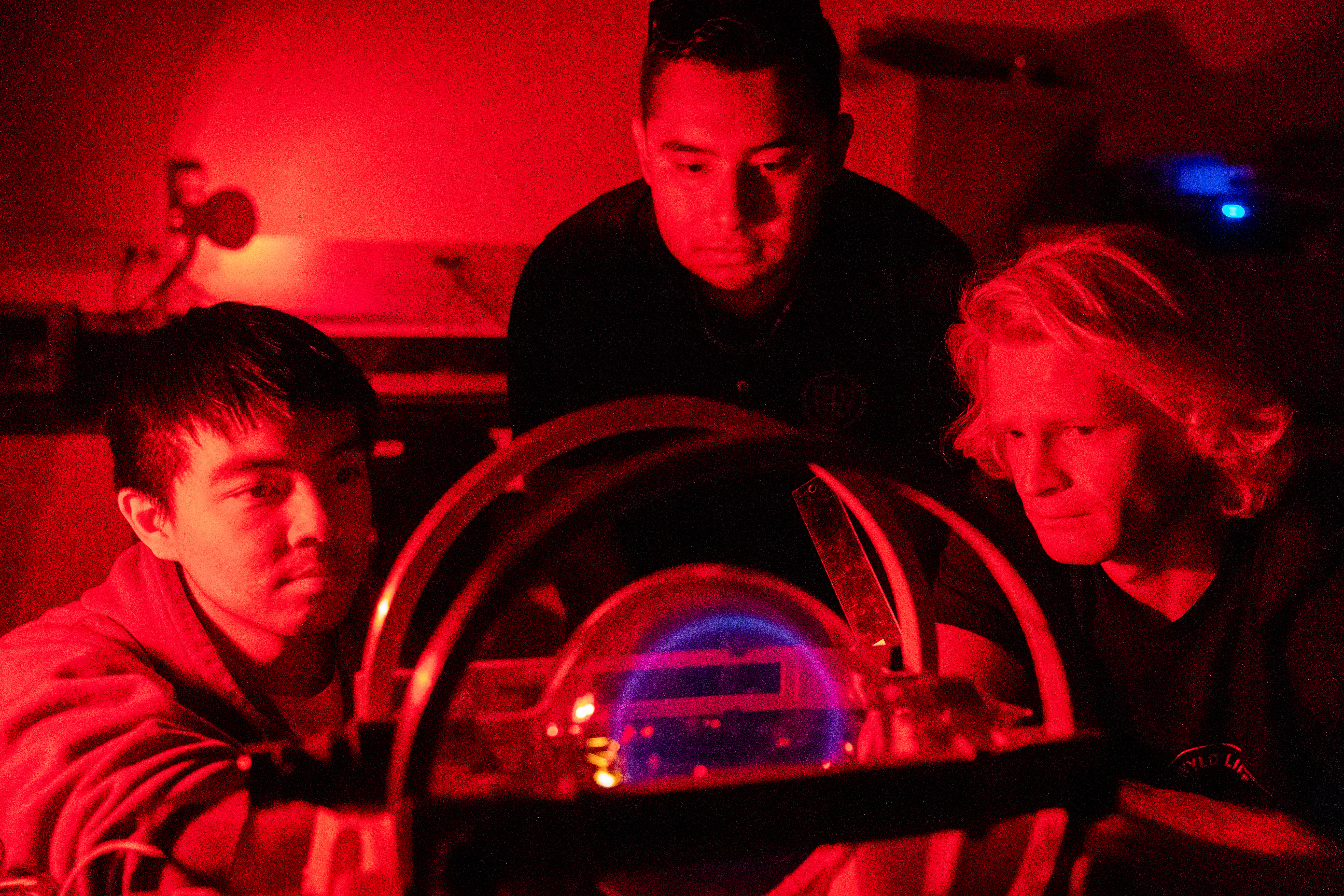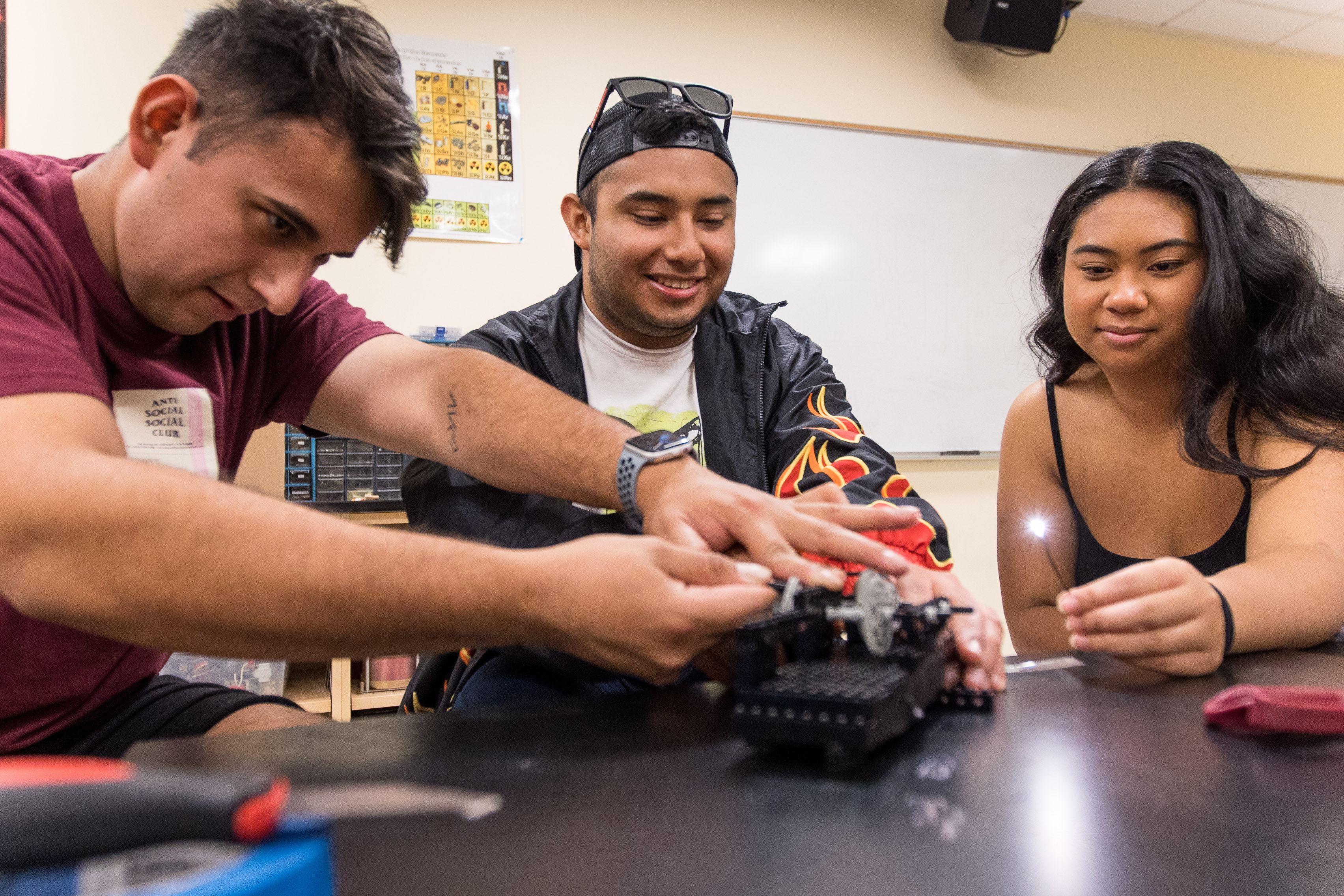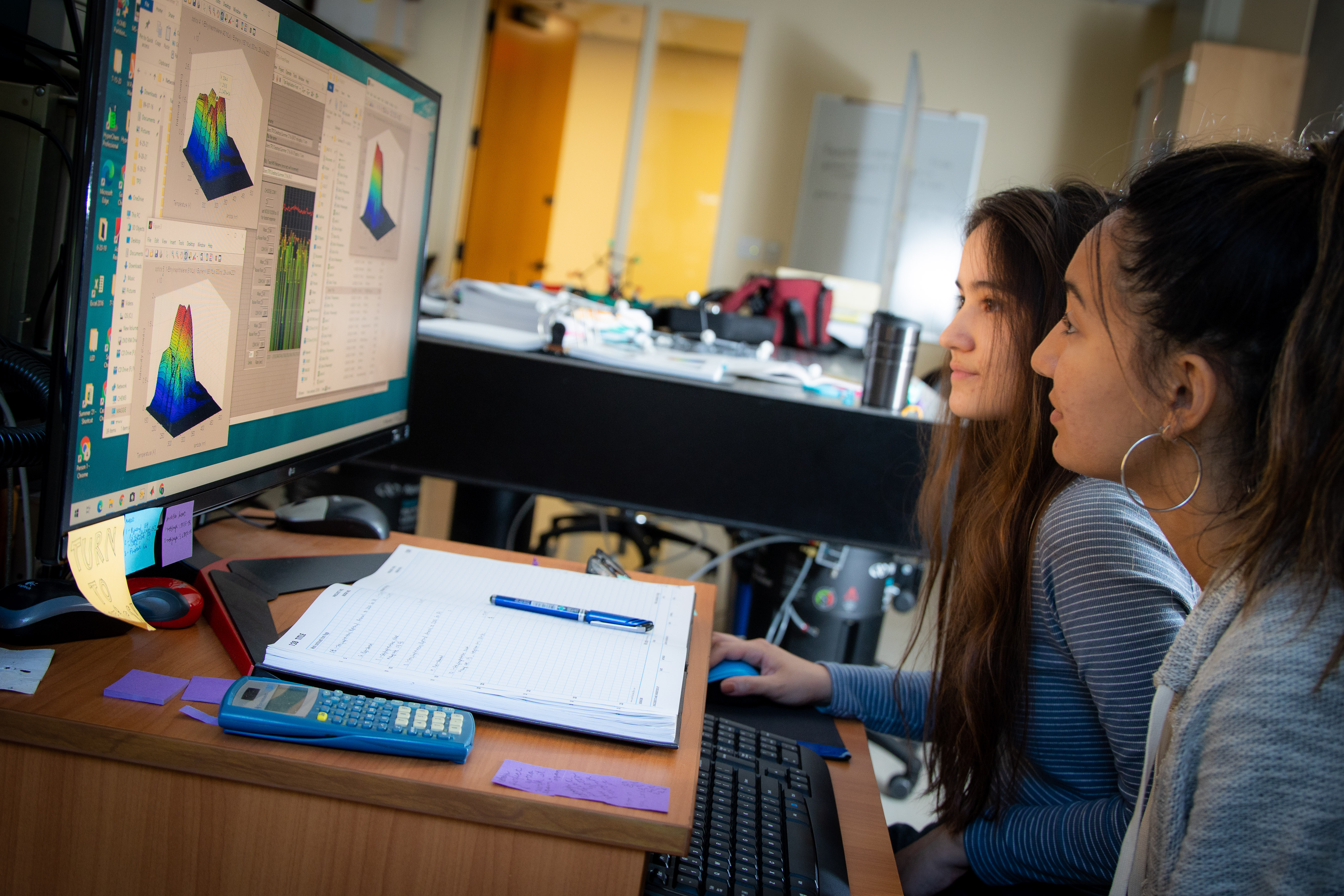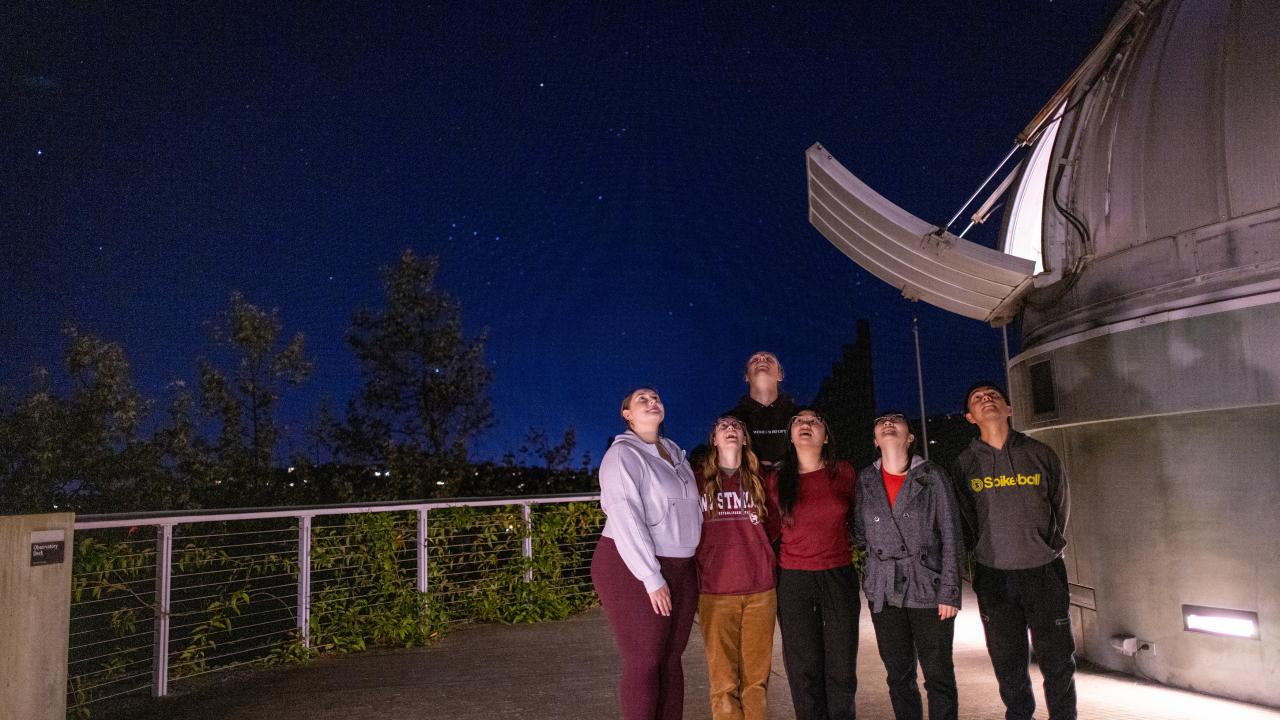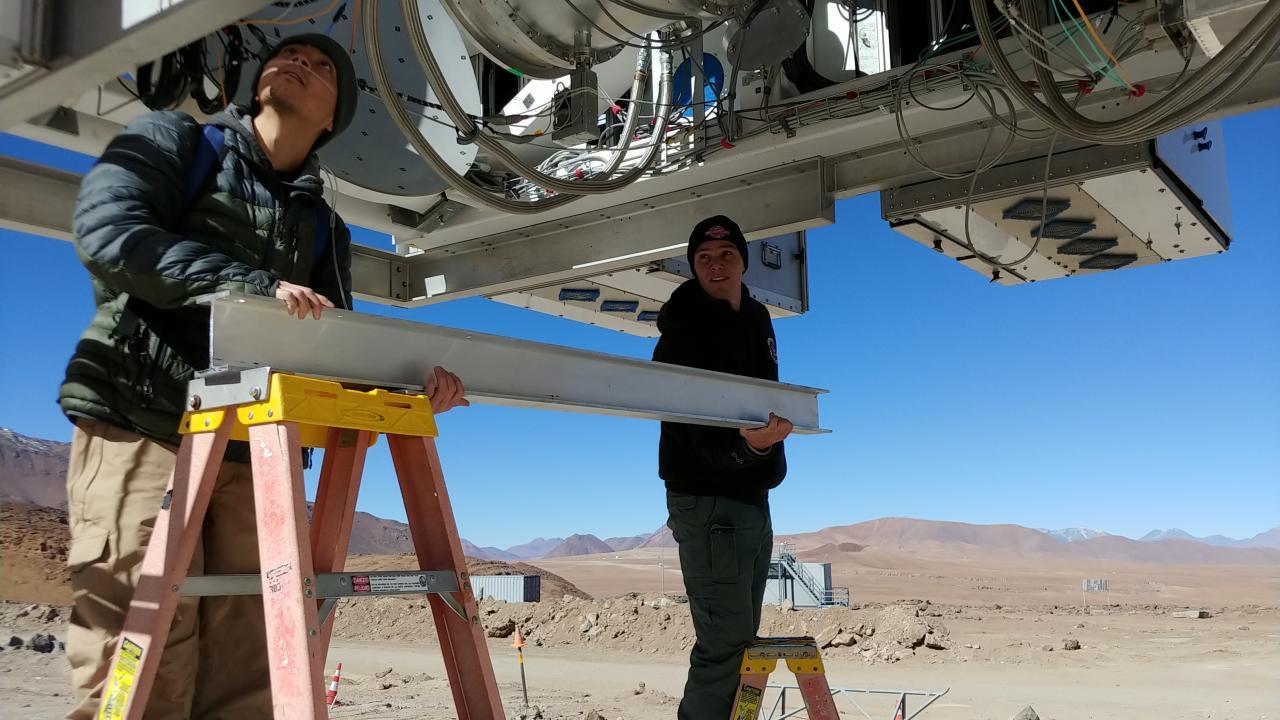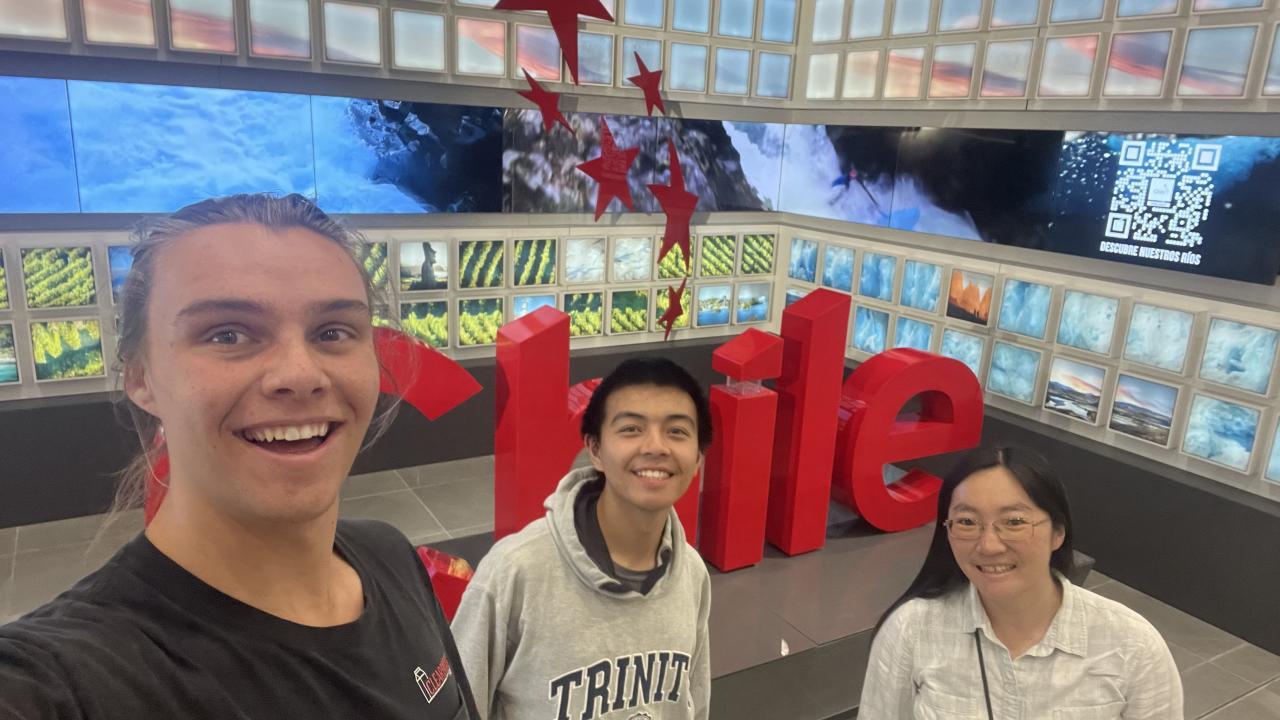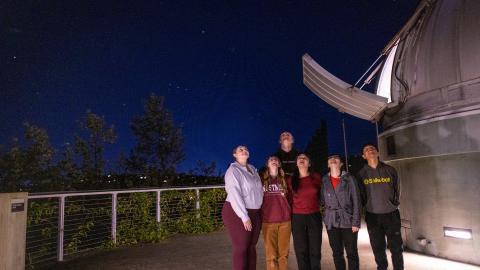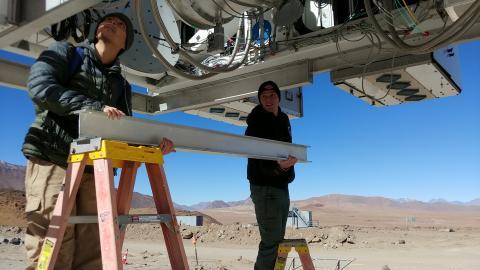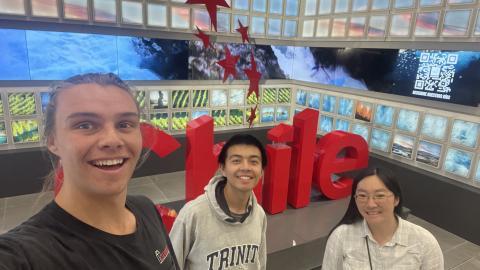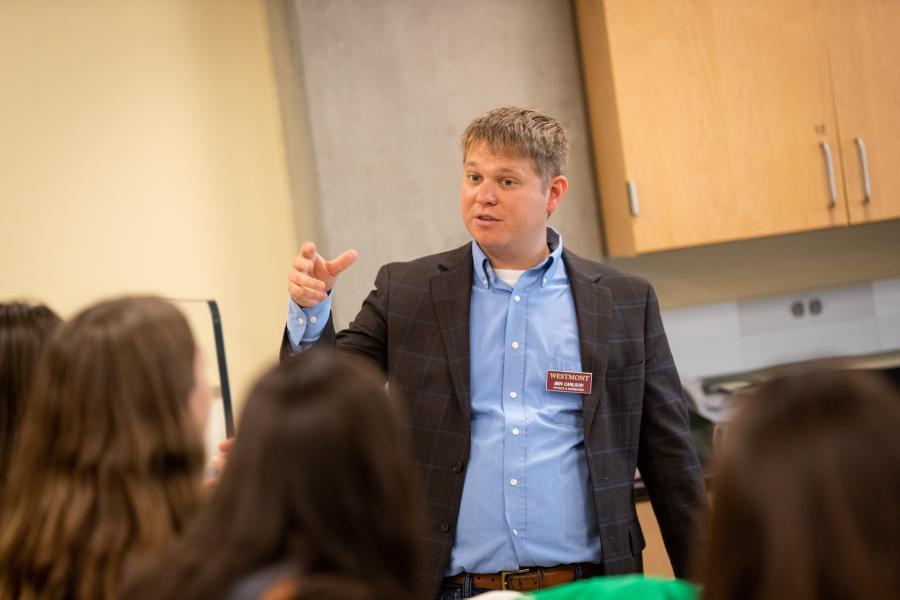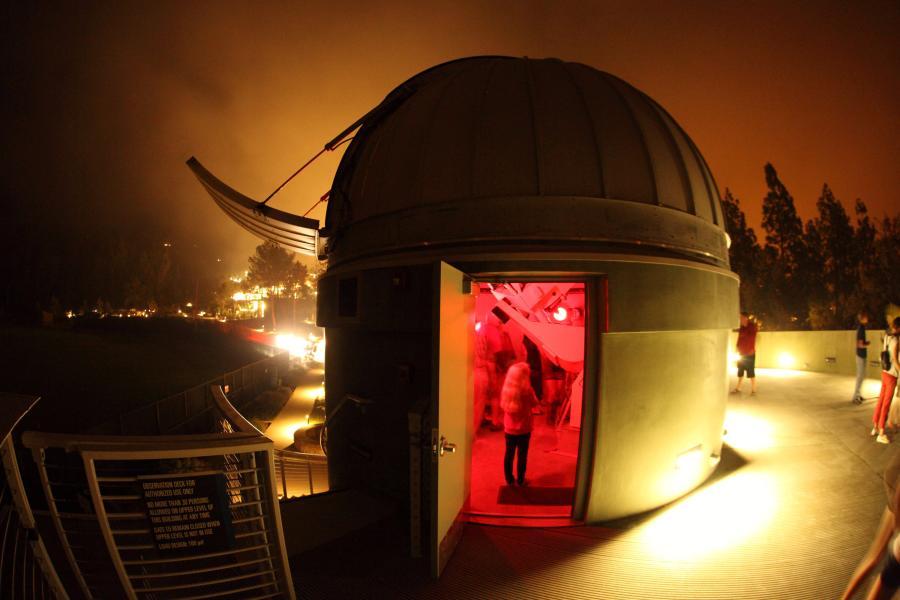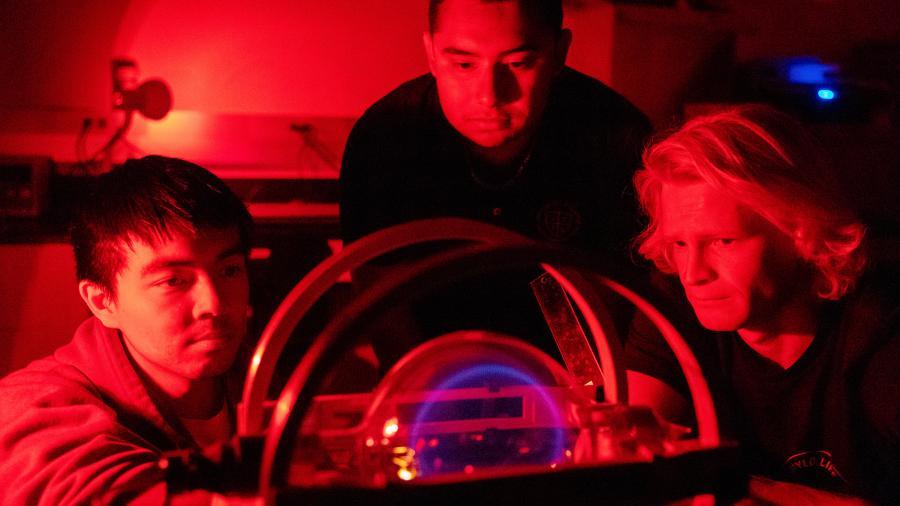When you study physics, you seek a fundamental understanding of the physical universe.
You’ll also take courses in mathematics, the language of science, and computer science for scientific breadth. Test some of the theories you learn in laboratory classes and hands-on research and take advantage of opportunities to conduct research with your professors. State-of-the-art instrumentation enriches your experience. You may also pursue internships with high-tech firms in Santa Barbara. Such practical training prepares you for graduate school and professional work in science, engineering and related fields. Interested in a double major? Take the B.A. track for greater breadth and flexibility.
Follow @westmontphysics on Instagram
Physics
Take courses in mathematics, the language of science, and computer science for scientific breadth. Test the theory you learn in laboratory classes and hands-on research and take advantage of opportunities to conduct research with your professors. The physics courses emphasize the fundamental science and mathematics essential for graduate study or professional work in physics.
Engineering Physics
Students may pursue the engineering physics major with core components in both physics and engineering.
Computation and Data Physics Track
Data runs the world now, and Westmont is keeping competitive in preparing students for industry by creating a new computational and data physics track offering that allows students to learn the skills that are valuable to all engineering/physics jobs today.
Physics Education
If you desire to teach junior high or high school physics, you can work with the Physics/Engineering and Education departments to obtain a teaching credential.
Astrophysics
The astrophysics minor provides a strong introduction to the field of astrophysics which studies the physical laws that govern our universe.
Highlights of Westmont Physics
Physics faculty are engaged in world-class experiments in experimental particle physics at the ATLAS experiment in Geneva Switzerland, and nuclear structure studies using gamma-ray spectroscopy at Florida State University and experimental cosmology at the Simmons Array in Chile. Internships and NSF funded summer research programs (REUs) at other institutions are also encouraged.
- Experimental Particle Physics
- Cosmology and Observational Astronomy
- Nuclear Physics
Student Interns
Students have the opportunity to participate in paid internships with faculty mentors over the summer.
2024
Under the research guidance of Dr. Carlson:
- Berit Lunstad (CERN)
- Michael Hemmett (CERN)
Chemistry research with Dr. Nishimura
- Reese Toepfler
2023
Under the research guidance of Dr. Carlson:
- Michael Hemmet (US ATLAS SUPER award, LBNL)
- Chandler Baker (CERN)
- Naomi Siragusa (CERN)
- Sean Ryan (CERN)
Berit Lunstad (CERN)
Under the research guidance of Dr. Ito:
- Michael Lew (Simons Array, Chile)
- Jacob Nelson (Simons Array, Chile)
Under the research guidance of Haring-Kaye:
- Natalie Fogg
- Reese Toepfer
2022
Under the research guidance of Dr. Carlson:
- Michael Lew
- Kirsten Potts
- Chandler Baker (CERN)
- Sean Ryan (CERN)
2021
REU (Research Experiences for Undergraduates) at UC Davis
Lexy Gillette
REU funded by the National Science Foundation.
Under the research guidance of Dr. Haring-Kaye:
- Kirsten Potts
- Danny Rubin
Ben Carlson
Roche, S.T., Bayer, Q., Carlson, B.T. et al. Nanosecond anomaly detection with decision trees and real-time application to exotic Higgs decays. Nature Communications 15, 3527 (2024).
See more of Dr. Carlson's publications
Robert Haring-Kaye
R.A. Haring-Kaye, F. Palombi, J. Döring, S.L. Tabor, B. Abromeit, R. Lubna, P.-L. Tai, Vandana Tripathi, A. Volya, J.M. VonMoss, D.C. Venegas-Vargas, C.L. Tan, M.J. Heeschen, K.Q. Le, and B.L. Harbin, "Onset of band structure in 70Ga," Phys. Rev. C 105, 054307 (2022).
See more of Dr. Haring-Kaye's publications
Jen Ito
The POLAR BEAR Collaboration, "Improved Upper Limit on Degree-scale CMB B-mode Polarization Power from the 670 Square-degree POLARBEAR Survey," , , 2203.02495.
See more of Dr. Ito's publications
Westmont Physics awarded $200,000 NSF Grant
A Westmont researcher has won a grant to further his search for evidence of the presence of mysterious dark matter. The National Science Foundation (NSF) has awarded a $200,000 grant to Ben Carlson, Westmont assistant professor of physics, to continue his work on the ATLAS experiment at the Large Hadron Collider (LHC) at CERN, a particle physics laboratory in Geneva, Switzerland. Continue reading article...
US ATLAS
Provided funds to support student travel to SLAC at Stanford for a training workshop in high energy physics.
California Space Grant Consortium
The California Space Grant Consortium provided funds to support students Michael Lew (physics, '24) and Josh Guinto (engineering, '24) for summer research during 2022. In the summer of 2023, Berit Lunstad ('26) and Naomi Siragusa ('24) were supported by the same grant.
Westmont Observatory
The Keck Telescope, a computer-controlled 24-inch F/8 Cassegrain reflector with Ritchey-Chretien optics (the same configuration used on the Hubble Space Telescope), has served as a versatile instrument for Westmont faculty and students for over a decade and remains one of the most powerful telescopes on the California Central Coast. Not only has the device been used for a variety of research projects and coursework, but it has also been a source of awe and inspiration for the greater Santa Barbara community. For more information, go to https://www.westmont.edu/westmont-observatory.
Common Study Area
Computer Lab
Modern Physics & Advanced Lab
Machine Shop
Scanning electron microscope
Gamma Ray Spectrometer
Maker Space Engineering Building
For more detailed information, see the Physics Facilities page.
At Westmont College, we believe community service is invaluable to growing as servant-leaders, so we have incorporated it into your general education requirements.
There are a variety of STEM specific opportunities for students to get involved:
- AP Physics Visit Day
- Astronomy Nights
- Boundless Brilliance
- Math Competition
If you are a high school or elementary school teacher interested in participating in an activity with Westmont College, please contact Dr. Ben Carlson.
Chisondi Warioba ('21), originally from Tanzania, moved to California when he was seven years old where he lived with his father and adoptive mother. Fueled by a passion for medicine, Chisondi initially chose Westmont to pursue a degree that would lead to medical school. By the time he graduated, Chisondi was one of only four students in his class who completed a triple major (Chemistry, Biology, and Physics). Not only did he excel at academics and research while at Westmont, he also assumed a leadership role in advancing racial justice and reconciliation, leading the Black Student Union his junior year and organizing discussion panels for Residence Life events centered around these and other social issues. At the 2021 Commencement exercises, Chisondi received the Dave Dolan Award in recognition of his leadership in responding to the social and spiritual needs of the college. Chisondi is currently pursuing a PhD in Medical Physics at the University of Chicago.
Lexy Gillette (’21) is currently working in the Clarke Research Group at the University of Oxford, researching layered magnetic materials and crystallography in solid state inorganic chemistry while pursuing her DPhil in Inorganic Chemistry.
“It’s been pretty great so far, and I get to use SQUID MPMS, XRPD, neutron diffraction and more to learn more about these materials (and make some new ones!)”
Sarah Reed ('19) interned at Northrop Grumman Space Systems in old town Goleta in her final semester at Westmont College. She was then hired on as a full time Electronics Engineer immediately upon graduating from Westmont. She works with a group of eight engineers in the Antenna Lab Department. She designs, builds and tests antennas for air and space crafts. She recently won a company award for developing a Spherical Near-Field Antenna Range at Northrop Grumman's site in Goleta!
As described by the American Physical Society, physics graduates pursue a broad range of careers.
Research Physicist
Science Writing
Patent Law
Software Development
Materials Research
Nuclear Medical Science
Technology Consultant
Forensic Science
Museum Education
Engineering (mechanical, electrical, process, civil, aeronautical, etc.)
Medicine
Technician
Teaching (High School or College)
See career paths in LinkedIn for graduates who majored or minored in physics at Westmont.
Senior physics major of the year
2024: Sean Ryan
2023: Daniel Rubin
2022: Lexy Gillette
Summer Undergraduate Program for Exceptional Researchers (SUPER)
Berit Lunstad (2024) was awarded a US ATLAS SUPER award to work with Dr. Ben Carlson on ATLAS research during the summer of 2024 at CERN. The $6,000 award consisted of a stipend for Berit, as well as the opportunity to present her work along with other students in the SUPER program.
Michael Hemmett (2023) was awarded a US ATLAS SUPER award for the project titled “Machine learning for calibration in the HL-LHC hardware trigger,“ consisting of a $5,500 stipend. He worked with Dr. Carlson from Westmont, alongside collaborators Elham Khoda and Shih-Chieh Hsu from University of Washington. The work will be based at Lawrence Berkeley National Lab.
Kirsten Potts (2022) was awarded a US ATLAS SUPER award to work with Dr. Ben Carlson on ATLAS research during the summer of 2022. The title of Kirsten's proposed project: "Search for low mass diphoton resonances with MET & triggers for photon + MET with machine learning." The $5,000 award consisted of a stipend for Kirsten, as well as the opportunity to present her work along with other students in the SUPER program.
LEXY GILLETTE
Physics and Chemistry Major Awarded Top Oxford Scholarship | Westmont senior Lexy Gillette, a double major in physics and chemistry, will attend the University of Oxford in the fall after earning the prestigious John and Daria Barry Foundation Scholarship.
CHISONDRI WARIOBA
Physics Alum Earns Prestigious Fellowship | Alumnus Chisondi Warioba ’21 has received a prestigious Graduate Research Fellowship from the National Science Foundation. The five-year fellowship provides three years of financial support that includes an annual stipend of $37,000. Warioba, a second-year graduate student halfway through his doctorate in medical physics at the University of Chicago, applied for the fellowship to continue research on his project, “fMRI and DTI analysis of functional connectivity loss related to cerebral arterial occlusion.” He plans to attend medical school and aspires to become a physician-scientist.
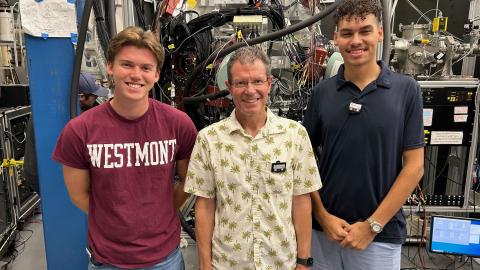
Physics students Josef Bingener ’25 and Ethan Camp ’27 participated in a novel nuclear physics experiment with Westmont professor Robert Haring-Kaye at Florida State University.
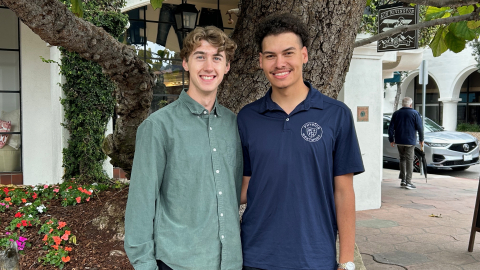
We celebrate the class of 2025, Michael Hemmett (left) and Josef Bingener (right).
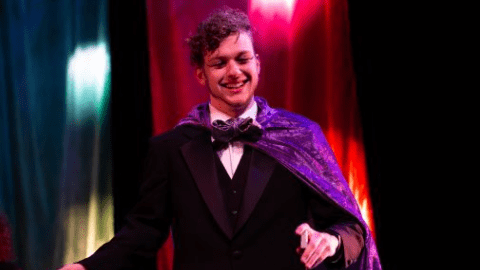
The 2024 outstanding senior in the Physics department is Sean Ryan, who has been a wonderful presence both in the department and in the larger Westmont community. Not only has Sean excelled academically, making valuable contributions to the ATLAS experiment at CERN for two summers, he has also blessed the Westmont community musically through his participation in Westmont Choir and Chamber singers.
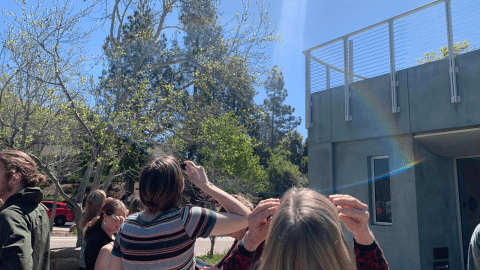
The solar eclipse that fascinated the nation this spring, although only at 55% maximum coverage in Santa Barbara, drew a crowd in excess of 100 students, faculty, staff, and administrators to the Westmont observatory on April 8, 2024.
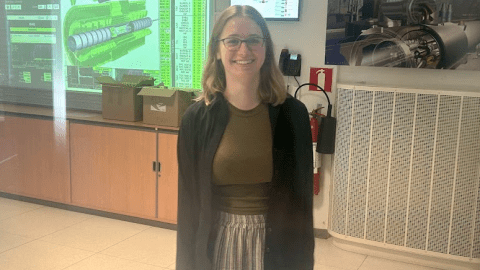
Berit Lunstad was awarded a US ATLAS SUPER award to work with Dr. Ben Carlson on ATLAS research during the summer of 2024 at CERN. The $6,000 award consisted of a stipend for Berit, as well as the opportunity to present her work along with other students in the SUPER program.
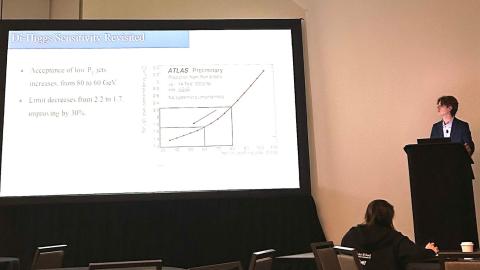
Michael Hemmett attended the APS April meeting in Sacramento, where he was able to hear presentations on the current physics, and presented a research as a contributed talk.
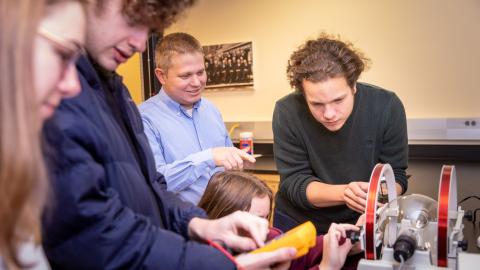
Dr. Carlson has co-authored a paper published in Nature Communications “Nanosecond anomaly detection with decision trees and real-time application to exotic Higgs decays“ that offers a new way to detect unknown physical processes such as rare exotic decays of the Higgs boson.
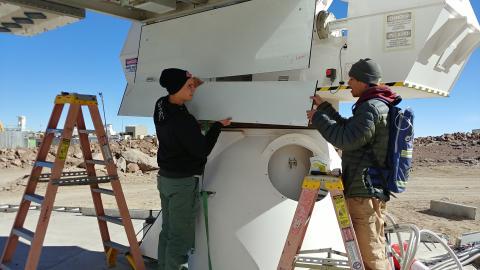
For the first time in more than a decade, undergraduate students assisted with research at the Simons Array, a set of three telescopes in the Atacama Desert in Chile at an elevation of about 17,000 feet. Westmont students Michael Lew and Jacob Nelson joined Jen Ito, assistant professor of physics, at the site, an expansion of the original POLARBEAR (POLARization of the Background Radiation) experiment that UC Berkeley pioneered to study the cosmic microwave background (CMB).
